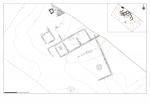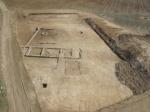Summary (English)
Research (January 2010 – December 2011)
The Roman rural establishment of La Peña II is a settlement of eminently agricultural characteristics linked to the agriculture and livestock exploitation of the immediate surroundings of the city of Segobriga. This settlement is thought to have been part of the rural population network that was established from the Julio-Claudian period. It is more likely, however, that the settlementbecame denser from the beginning of the Flavian period in the area near the city. It took the form of scattered farms of different status, similar to those which characterized the territory of the diverse towns and colonies socially and economically. It is certain that this agricultural exploitation would be associated with the people who lived in or around Segóbriga.
As typologies of the different Hispanic-Roman rural complexes are very diverse, it is hard to define to which of them the site of La Peña II belongs. In principle, La Peña II could be identified as a small farm. However, given the fragmented condition in which the ensemble has been preserved, this complex could be similarly considered as the pars _fructuaria dependent on a nearby villa which, in turn, would contain a pars urbana . Therefore, we can not exclude that the other facilities belonging to a “traditional” villa could be found in an area close to the excavation. This has been the case of other settlements which were dug out in 2010 in the surroundings of the region of Segóbriga (Llanos de Pinilla, Los Vallejos and Casas de Luján).
The economic wealth of Segóbriga is based especially on its mining resources but, at the same time, the township features suitable conditions for the development of a Mediterranean agriculture in which olives, vines and cereal farming are combined with cattle breeding. While there is no evidence of the first yet, the rest are surely exposed in La Peña II. Analytical studies, particularly carpological and palynological, in addition to the documented material culture confirm the practice of a mixed operation in which the culture of the cereal, livestock, and apiculture are included. Viticulture would be a further component.
(translation by Alba López Fregeneda)
- Jorge Morín de Pablos
Director
- Jorge Morín de Pablos (Dpto. de Arqueología de AUDEMA)
Team
- Mónica Ruiz Alonso y Leonor Peña-Chocarro (CSIC)
- Pablo Guerra García y José Manuel Illán Illán (AUDEMA)
- Daj Luay Mohamadieh
- Francisco José López Fraile y Rui R. de Almeida (Dpto. de Arqueología de AUDEMA)
- Khairieh 'amr
- Khalil Hamden
- Museo de Cuenca
Research Body
- Departamento de Arqueología de AUDEMA
- Grupo de Investigación Arqueobiología del Instituto de Historia del Centro de Ciencias Humanas y Sociales del CSIC
Funding Body
- AUDEMA






![Download [PDF]](/excavation/skins/fasti/images/results/download_sml.png)


